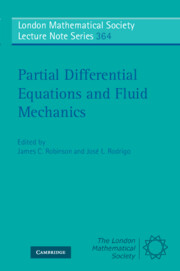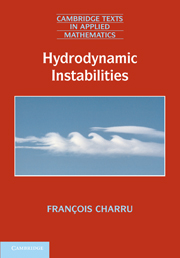3654 results in ebooks in fluid mechanics
13 - Epilogue: a turbulence timeline
-
-
- Book:
- A Voyage Through Turbulence
- Published online:
- 07 October 2011
- Print publication:
- 08 September 2011, pp 426-434
-
- Chapter
- Export citation
List of contributors
-
- Book:
- A Voyage Through Turbulence
- Published online:
- 07 October 2011
- Print publication:
- 08 September 2011, pp ix-x
-
- Chapter
- Export citation
4 - G.I. Taylor: the inspiration behind the Cambridge school
-
-
- Book:
- A Voyage Through Turbulence
- Published online:
- 07 October 2011
- Print publication:
- 08 September 2011, pp 127-186
-
- Chapter
- Export citation
11 - Satish Dhawan
-
-
- Book:
- A Voyage Through Turbulence
- Published online:
- 07 October 2011
- Print publication:
- 08 September 2011, pp 373-392
-
- Chapter
- Export citation
Frontmatter
-
- Book:
- A Voyage Through Turbulence
- Published online:
- 07 October 2011
- Print publication:
- 08 September 2011, pp i-iv
-
- Chapter
- Export citation
3 - Theodore von Kármán
-
-
- Book:
- A Voyage Through Turbulence
- Published online:
- 07 October 2011
- Print publication:
- 08 September 2011, pp 101-126
-
- Chapter
- Export citation
7 - Stanley Corrsin
-
-
- Book:
- A Voyage Through Turbulence
- Published online:
- 07 October 2011
- Print publication:
- 08 September 2011, pp 238-275
-
- Chapter
- Export citation
10 - Robert H. Kraichnan
-
-
- Book:
- A Voyage Through Turbulence
- Published online:
- 07 October 2011
- Print publication:
- 08 September 2011, pp 329-372
-
- Chapter
- Export citation
5 - Lewis Fry Richardson
-
-
- Book:
- A Voyage Through Turbulence
- Published online:
- 07 October 2011
- Print publication:
- 08 September 2011, pp 187-208
-
- Chapter
- Export citation
8 - George Batchelor: the post-war renaissance of research in turbulence
-
-
- Book:
- A Voyage Through Turbulence
- Published online:
- 07 October 2011
- Print publication:
- 08 September 2011, pp 276-304
-
- Chapter
- Export citation
12 - Philip G. Saffman
-
-
- Book:
- A Voyage Through Turbulence
- Published online:
- 07 October 2011
- Print publication:
- 08 September 2011, pp 393-425
-
- Chapter
- Export citation
Preface
-
-
- Book:
- A Voyage Through Turbulence
- Published online:
- 07 October 2011
- Print publication:
- 08 September 2011, pp xi-xvi
-
- Chapter
- Export citation
1 - Osborne Reynolds: a turbulent life
-
-
- Book:
- A Voyage Through Turbulence
- Published online:
- 07 October 2011
- Print publication:
- 08 September 2011, pp 1-39
-
- Chapter
- Export citation
9 - A.A. Townsend
-
-
- Book:
- A Voyage Through Turbulence
- Published online:
- 07 October 2011
- Print publication:
- 08 September 2011, pp 305-328
-
- Chapter
- Export citation
6 - The Russian school
-
-
- Book:
- A Voyage Through Turbulence
- Published online:
- 07 October 2011
- Print publication:
- 08 September 2011, pp 209-237
-
- Chapter
- Export citation

Partial Differential Equations and Fluid Mechanics
-
- Published online:
- 07 September 2011
- Print publication:
- 16 July 2009

Hydrodynamic Instabilities
-
- Published online:
- 05 August 2011
- Print publication:
- 30 June 2011
Video resources
-
- Book:
- Hydrodynamic Instabilities
- Published online:
- 05 August 2011
- Print publication:
- 30 June 2011, pp xvi-xviii
-
- Chapter
- Export citation
9 - Nonlinear dispersive waves
-
- Book:
- Hydrodynamic Instabilities
- Published online:
- 05 August 2011
- Print publication:
- 30 June 2011, pp 274-298
-
- Chapter
- Export citation
7 - Avalanches, ripples, and dunes
-
- Book:
- Hydrodynamic Instabilities
- Published online:
- 05 August 2011
- Print publication:
- 30 June 2011, pp 201-245
-
- Chapter
- Export citation
